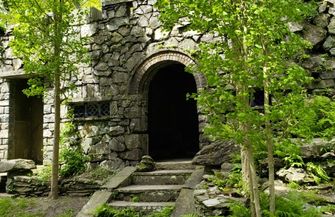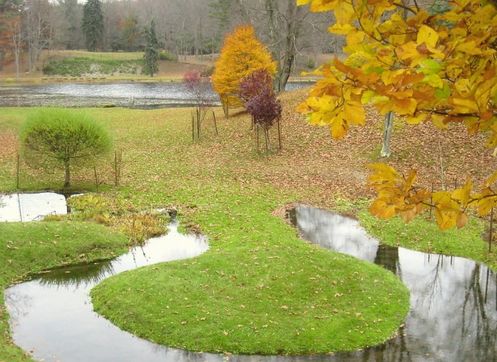
Innisfree Garden is a 200-acre preserve located some 90 miles north of New York City. This masterpiece is a result of decades of dedication and shows the best of both American and Eastern aesthetics. The garden is the work of Walter Beck, Marion Beck, and their architect Lester Collins, in the early 1930s.
The Becks had the option of going with typical English gardens for their mansion but were ardent on looking for a suitable alternative. Beck saw the paintings of Wang Wei, a Chinese Painter from the eighth century. These paintings inspired Beck to create a garden with self-contained landscapes that mix natural elements such as streams, plants, and rocks to compose and frame nature.
Over the course of several years, Innisfree Garden became one of the most frequently visited gardens in the world. Visitors describe Innisfree’s gardens as ‘subtly beautiful’ and ‘disarmingly simple’.
A Humble Garden with Many Stories to Tell

Innisfree Garden may be smaller than most botanical gardens in New York, but there is much to explore here. It would be hard to put the sights, sounds, and fragrances of the garden into words. Innisfree is best experienced firsthand.
It takes about 90 minutes to explore the 185-acre garden. But we recommend taking longer to explore every square inch of the garden to see more of it. Visitors can complete the main trail, which winds its way around a small lake at the heart of the garden.
Gardening enthusiasts may want to spend longer here and may want to plan a weekend getaway at Innisfree Garden for complete exploration. The waterfalls, trails, lake, and core garden deserve closer inspections.
The lake, in particular, is particularly beautiful and should be seen from multiple angles. A look inside the lake will reveal wildlife ranging from frogs and turtles to fish and showy plants.
The trail itself is not difficult to explore but it is a good idea to use a pair of decent walking shoes. Parts of Innisfree garden are accessible to wheelchair-bound individuals.
The History
Innisfree Garden was built over the course of 50 years, mainly led by landscape architect Lester Collins and his clients Walter Beck and Marion Beck. The Becks started their work at Innisfree in the 1920s and Collins joined the couple in 1938.
After the death of Marion Beck in 1959, the management of the garden was led by Collins, who faced financial difficulties. He laid off 20 gardeners and redesigned the garden by adding new trees and fountains.
Collins’ goal was to create a self-sustaining garden that relies more on patience and knowledge than labor or capital to create natural ecosystems.
Innisfree garden was eventually open to the public in 1960 after the formation of a non-profit organization. In the early 1970s, parts of the land were sold to Rockefeller University to be used as a research station and preserve.
The garden borrows heavily from Chinese and Japanese garden design ideas. The official Innisfree website describes the garden as a ‘distinctly American stroll garden’ that is surrounded by a sprawling, shimmering lake.
Part of what makes Innisfree so beautiful is the use of lights to highlight special events and areas of the garden. Innisfree Garden also hosts a number of special tours depending on the season.
The Catalog of Flowers
Although Innisfree Garden is noted for its Asian garden traditions, it does have a vast collection of native American plants. Visitors will be surprised to learn that over 40% of the flowers here are wildflowers. Some of these flowers have been seeded naturally by birds, animals, and the wind.
However, most of the colorful plants have been planted very carefully to help them grow and thrive out of their comfort zone.
According to the official Innisfree Catalog of Wildflowers, there are about 125 species of plants to see. However, there are unlisted wildflowers in the garden that are discovered every now and then.
Visiting Innisfree Garden
Innisfree Garden is open to the public Wednesday through Sunday from May 7 to October 20. Management charges an admission fee from visitors.
Visitors are required to purchase tickets in advance to visit the garden and can choose from three different two-hour time slots. They must complete their entire visit within that two-hour window.
Visitors will be asked to park at the front entrance until their scheduled time slot. This is important because it allows visitors exiting the park to clear the parking lot before the new group enters.
The facility has three porta potties available. There are no other onsite restrooms available. Depending on how busy the garden gets, the rest rooms may not have a working soap or sanitizer dispenser available.
Visitors have two options for starting. They can walk along the lake or head to the core garden. Most visitors prefer to visit the core garden first. However, if the core garden is too crowded, you can go ahead and check out the lake first.
If you decide to check out the lake, it’s a 1.3-mile walk – the trail is uneven and not handicap accessible. The core garden lets you walk along the lathe path, but once you reach the end of the core garden, you’ll have to follow the trail around the lake in a counterclockwise direction.
It is recommended to use a map to identify the various parts of the garden. There are ponds, bridges, caves, rocks, brick walls, and even waterfalls to explore. Every part of the garden is laid out carefully and maintained by experts.
Make sure to bring out your cameras to get the most out of your trip to Innisfree Garden. Make sure to visit in the fall months to witness the extra colorful foliage. Don’t wait too long though because the garden is only open from May 7 through October 20.
Wrapping Up
Innisfree Garden is an idyllic and peaceful place to enjoy your time. It may not be the biggest botanical garden in New York, but it definitely makes every square inch count. Besides the flowers and perennials, there are other features that are worth visiting, including waterfalls and caves.
